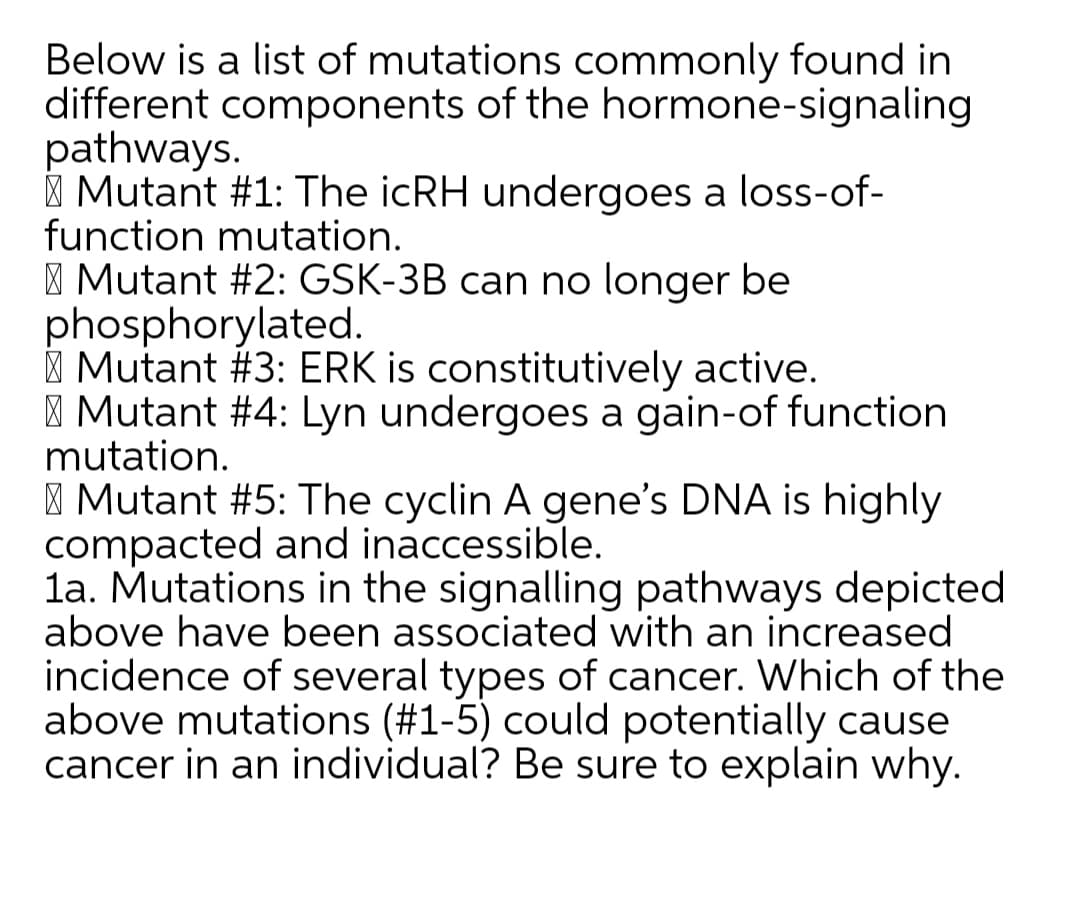Below is a list of mutations commonly found in different components of the hormone-signaling pathways. | Mutant #1: The icRH undergoes a loss-of- function mutation. | Mutant #2: GSK-3B can no longer be phosphorylated. I Mutant #3: ERK is constitutively active. | Mutant #4: Lyn undergoes a gain-of function mutation. | Mutant #5: The cyclin A gene's DNA is highly compacted and inaccessible. la. Mutations in the signalling pathways depicted above have been associated with an increased incidence of several types of cancer. Which of the above mutations (#1-5) could potentially cause cancer in an individual? Be sure to explain why.
Below is a list of mutations commonly found in different components of the hormone-signaling pathways. | Mutant #1: The icRH undergoes a loss-of- function mutation. | Mutant #2: GSK-3B can no longer be phosphorylated. I Mutant #3: ERK is constitutively active. | Mutant #4: Lyn undergoes a gain-of function mutation. | Mutant #5: The cyclin A gene's DNA is highly compacted and inaccessible. la. Mutations in the signalling pathways depicted above have been associated with an increased incidence of several types of cancer. Which of the above mutations (#1-5) could potentially cause cancer in an individual? Be sure to explain why.
Human Physiology: From Cells to Systems (MindTap Course List)
9th Edition
ISBN:9781285866932
Author:Lauralee Sherwood
Publisher:Lauralee Sherwood
Chapter4: Principles Of Neural And Hormonal Communication
Section: Chapter Questions
Problem 5TAHL
Related questions
Question
Please help ASAP within an hour need to submit it urgently

Transcribed Image Text:Below is a list of mutations commonly found in
different components of the hormone-signaling
pathways.
| Mutant #1: The icRH undergoes a loss-of-
function mutation.
| Mutant #2: GSK-3B can no longer be
phosphorylated.
| Mutant #3: ERK is constitutively active.
| Mutant #4: Lyn undergoes a gain-of function
mutation.
| Mutant #5: The cyclin A gene's DNA is highly
compacted and inaccessible.
la. Mutations in the signalling pathways depicted
above have been associated with an increased
incidence of several types of cancer. Which of the
above mutations (#1-5) could potentially cause
cancer in an individual? Be sure to explain why.
Expert Solution
This question has been solved!
Explore an expertly crafted, step-by-step solution for a thorough understanding of key concepts.
Step by step
Solved in 2 steps

Knowledge Booster
Learn more about
Need a deep-dive on the concept behind this application? Look no further. Learn more about this topic, biology and related others by exploring similar questions and additional content below.Recommended textbooks for you

Human Physiology: From Cells to Systems (MindTap …
Biology
ISBN:
9781285866932
Author:
Lauralee Sherwood
Publisher:
Cengage Learning

Human Physiology: From Cells to Systems (MindTap …
Biology
ISBN:
9781285866932
Author:
Lauralee Sherwood
Publisher:
Cengage Learning